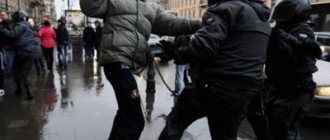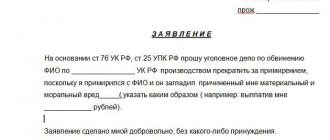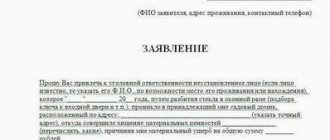Assaulting a police officer is a great way to ruin your life for anywhere from 360 hours to 20 years. And in especially severe cases - forever, because life imprisonment can hardly be called a pleasant life. And even if you did not use force, but simply “sent away” a law enforcement officer out of emotion, this will not end well for you.
But, as they say, everyone is strong in hindsight. If, after all, you recklessly attacked a police officer, you cannot do without legal help.
As practice shows, courts rarely treat those who have violated the honor, life and health of their colleagues leniently. So hiring a good lawyer is the first thing you should do.
Do you want to figure it out, but don’t have time to read the article? Lawyers will help
Entrust the task to professionals. Lawyers will complete the order at the cost you specify
27 lawyers on RTIGER.com can help with this issue
Solve the issue >
Basic Concepts
Law enforcement officers, while performing their official duties, are constantly in particular danger; the legislator, in turn, must provide people serving the state with decent protection. The Criminal Code provides for an article for attacking a police officer while on duty, as well as punishment for an attempt on his life. A person who violates a rule of law is held accountable and punished on a general basis.
An article of the Criminal Code defines an attack on a police officer as a particularly serious crime.
An attempt on the life of a police officer or an attack on him is committed with direct intent. The criminal is aware of his actions, and their illegal nature, accordingly, must be punished. Moreover, the actions of the perpetrator are of an impudent nature and are aimed not specifically at a person as an individual, but at a representative of the authorities. By his actions, the attacker disrespects the existing state apparatus. The subject of the violation is a sane person who has reached the age of sixteen. The criminal law considers the purpose of a crime to be obstructing the performance of direct duties by a police officer. This motive is often supplemented by the desire to hide another crime, personal hostility and hooliganism.
The object of the encroachment, according to Article 317 of the Criminal Code of the Russian Federation and the commentary to it, is the work of law enforcement agencies. The objective side of the violation is the use or threat of violence against a law enforcement officer. If there is a murder of a police officer, Article 317 of the Criminal Code of the Russian Federation considers an encroachment on the life of a law enforcement officer as an objective party. If at the time the crime was committed, the victim was not on duty (was not wearing a uniform), then the actions of the criminal are qualified under Article 317 of the Criminal Code of the Russian Federation, but only if this is retaliation for his professional activities. In another situation, the perpetrator will be held liable under Article 105 of the Criminal Code of the Russian Federation - murder.
Article 318 considers an attack on an officer during execution to be completed at the moment of the use of physical or mental violence against the police officer.
Responsibility for assaulting a police officer
A law enforcement officer has a special status as a representative of the government, whose tasks are to ensure order and security in society, as well as to protect the rights of subjects.
Therefore, an attack on his life and health, personal integrity, honor and dignity entails criminal punishment.
Sanctions apply:
- for attempting or committing murder;
- for violent acts.
An article of the code classifies an attack on a police officer during execution as a particularly serious crime.
In addition to the life of the employee, these acts endanger the lives of people close to him, and also violate the mechanism for fulfilling the assigned tasks. How much do they pay for killing a policeman, says Art. 317 of the Criminal Code of the Russian Federation. The offender is punished by imprisonment for a term of twelve to a couple of decades; life imprisonment may also be imposed if there are aggravating circumstances.
Prevention of crimes against police officers
The Ministry of Internal Affairs of the Russian Federation keeps records of crimes.
Crime against the management system is under special control. According to the records, attacks on law enforcement officers are quite common. More than ten thousand cases have been recorded since the beginning of this year. Most of them occurred during execution. The situation with crime against employees of competent structures requires active measures for prevention and prevention.
The main directions of prevention are:
- personnel training;
- the issue of employee responsibility for the use of weapons.
Rigid order, thorough investigation, reporting for every shot fired during execution, presumed “future guilt” and sanctions for these actions, which do not contribute to the healthy use of weapons for self-defense, and therefore the practical side of responsibility for the use of weapons needs adjustments.
Punishment for defamation of a judge or jury
Article 298.1 of the Criminal Code of the Russian Federation establishes criminal liability for slander against a judge , juror or other person involved in the administration of justice in connection with the consideration of cases or materials in court (Part 1 of Article 298.1 of the Criminal Code of the Russian Federation), slander committed against a prosecutor, investigator , the person conducting the inquiry, in connection with the preliminary investigation (Part 2 of Article 298.1 of the Criminal Code of the Russian Federation), as well as for slander associated with accusing a person of committing a grave or especially grave crime (Part 3 of Article 298.1 of the Criminal Code of the Russian Federation). The maximum punishment for this crime is a fine of up to five million rubles.
What is beating
When considering beating from the point of view of criminal law, one should focus on the characteristics and elements of the crime. The object of beating is the personal inviolability of a person from physical and psychological influence of a negative nature
These rights are enshrined in the fundamental document - the Constitution of the Russian Federation.
The objective side of beating cases is considered to be the infliction of physical injuries that cause inconvenience in terms of the victim’s disability. Here we can also talk about moral damage, since mutilation is a way of psychologically influencing the victim.
The corpus delicti consists of two parts:
- Infliction of bodily harm is the active actions of a criminal, characterized by physical blows to the body of the victim. As a result, the other side develops bruises, abrasions, cuts, bruises, deep wounds and other damage to the skin. In the case of beatings, the openness of the damage may not appear. Then you should pay attention to the second component of the crime.
- Intentional act - by exerting physical pressure on the victim, the criminal takes conscious actions. Even if this manifests itself in a state of passion or under the influence of alcoholic intoxication, the perpetrator will face criminal punishment.
3 options to get free help from experienced lawyers
- Online chat - describe the situation to find out from a legal consultant how to solve your problem
- Hotline – (Moscow and region) or 8 800 511 38 27 (Other regions of the Russian Federation)
- Online consultation - help on the page
The subjects of the crime are individuals, and in our case, police officers who are on duty or performing an undercover task.
Insulting a police officer while on duty
Insulting a law enforcement officer is punishable by Art. 319 of the Criminal Code of the Russian Federation. Insults expressed verbally or in writing are sufficient grounds for a crime, which can be divided into:
- objective - the official position of the victim, the specifics and form of the insult, the date, place of the incident;
- subjective - intention, reason, fact of guilt.
The severity of the offense committed will be determined based on a number of factors. To hold a person accountable, the following requirements are taken into account:
- the person charged with insulting a law enforcement officer must be 16 years old;
- there are witnesses present when the act is committed;
- malicious intent of the act;
- intentionality of the act;
- a form of insult.
Punishment includes a fine (40 thousand rubles or in the amount of 3 months’ earnings of the convicted person) or correctional labor (up to 12 months).
Commentary on Article 318 of the Criminal Code of the Russian Federation
1. The objects of criminal assault are the health and mental integrity of the victim, as well as the normal public activities of government bodies.
2. The victims of this crime may be, according to the note. to Art. 318 an official of a law enforcement agency or another official who has organizational and administrative powers in relation to an unlimited and indefinite number of persons independent of him in service. In addition to the named persons, victims of a crime may be relatives of the mentioned persons (on the concept of close persons, see commentary to Article 317).
3. The objective side of the crime (Part 1) is expressed in the use of violence, not dangerous to life or health, to those named in the comment. article to persons or the threat of violence against them. Violence that is not dangerous to life or health means beating the victim or committing other violent acts that do not entail any harm to his health. The content of the threat can be different, up to the threat of murder, and also vague. The threat of violence must be real, i.e. such that the victim has reason to fear that the threat will be carried out. The ways of expressing a threat can be different: verbally (words), gestures, or in writing.
4. Necessary for qualifying an act as a crime is the use of violence or threat against a representative of the government or his relatives, carried out in connection with the performance of their duties. The concept “in connection with the performance of official duties by a representative of the authorities” covers both the time of violence or the threat of its use during the performance of his official duties by the victim, and the time when they have already been performed. The use of violence or threat of violence not in connection with the performance of duties by an official does not constitute a crime under Art. 318.
5. Part 2 comments. Article is subject to application in cases where violence dangerous to life or health is used against a government official or his relatives. Violence dangerous to life or health should be understood as violence that resulted in the infliction of light, moderate or severe harm to the health of the victim, as well as violence that, although it did not result in the specified harm, however, by its nature at the time of application created a real danger of causing harm to the life or health of these persons. Part 2 only implies physical violence.
6. To qualify the actions of a person expressed in the use of violence or the threat of its use in relation to a representative of the authorities, under Art. 318 it is necessary to establish that the victim performed official duties legally. The use of violence or the threat of violence outside of the performance of official duties by the victim should be qualified under the article of the Criminal Code of the Russian Federation on crimes against the person.
7. The crime is completed (by elements) at the moment of the use of physical or mental violence, regardless of whether the perpetrator succeeded or not in preventing a representative of the authorities from performing his official duties.
8. The subjective side of the crime is characterized by direct intent. Motive and purpose are not constructive elements of the composition, unlike Art. 317, however, they cannot be anything that is not related to the performance by the victim of his official duties.
9. The subject of a criminal offense is a physically sane person who has reached the age of 16.
10. Actions enshrined in part 1 of the comment. Articles are classified by the legislator as crimes of medium gravity, and in Part 2 - as serious crimes.
Violent acts against a law enforcement officer
Violent acts or threats against a police officer (Article 318 of the Criminal Code) are also criminally punishable.
The Code contains a note according to which the victim can be any entity with control and administrative powers, namely:
- Law enforcement officer.
- Controlling authority official.
- Local government representative.
The object of the attack, as in the case of murder, is the work of law enforcement agencies.
The danger to life or health arising from the offense affects the severity of liability. The infliction of such violence must be associated with the legitimate activity of the victim. If, as a result of the investigation, this connection is not discerned, then the act is qualified as robbery under Part 4 of Art. 162 of the Criminal Code.
Qualification problems
Due to the specific nature of the work of police officers, when considering each case of an attack on one of them, investigators systematically face problems of classifying the crime.
Facts, explanatory evidence on behalf of the victim, explaining his actions and the reasons that led to this, are collected by the police. The circumstances of the crime are being studied by employees of the Investigative Committee of the Russian Federation.
A conscientious investigator should consider the following points:
- The merits, professionalism of the victim and the circumstances of the crime.
- Whether the attack was committed by the accused citizen in a state of passion due to a previous clash with government officials or for other reasons not related to his relationship with the police.
- How accurately was the examination carried out to record the injuries of the injured and accused parties?
- Was the police officer's behavior correct and lawful before the attack?
- How impartial will it be to collect facts about the essence and circumstances of the conflict and to pass a sentence on the accused of assault if the case is supervised by a person who is, for example, a close friend of the injured or accused party?
In a number of cases, when minor injuries are inflicted on a police officer and the facts are clarified, somewhat mitigating the offense of the accused party, and, of course, consent on behalf of the injured party, the result of the investigation into the case of an attack on a law enforcement officer may be an apology from the accused to the accused.
In other circumstances, the accused is awarded a fine, forced labor, or a prison term.
Qualification nuances
One of the stages of the criminal legal assessment of a crime is to determine its composition, including:
- subject;
- an object;
- subjective and objective side.
Criminal liability for an unlawful act against a police officer arises from the person's 16th birthday.
If the act was committed by a person at an earlier age, then paragraph “b” of Part 2 of Art. 105. An attack on an employee of a government agency is committed only intentionally, and its motive is the desire to take revenge for lawful activities, and the ultimate goal is to interfere with the work of the persons referred to in Art. 317 of the Criminal Code of the Russian Federation and commentary to it.
Therefore, the victim, according to this norm, is only a law enforcement officer or a military man. An attempted murder is often committed directly during the performance of official duties.
If at the time of the commission of the act the employee is not on duty, then the action is qualified under Article 317 only if it is an act of revenge for his activities. The elements of the crime arise from the moment of the attempt on the life of the victim.
How is an assault considered if a police officer attacked himself?
When making arrests, police officers often have to use force. And we are not talking about shooting and the use of special equipment, but about very standard blows, grabs and other techniques that in one way or another can cause harm to the detainee. However, they cannot use force just like that, at will - laws and regulations oblige them to use force only after a warning, and they themselves must not be dangerous to the life of the victim.
The police officer is also required to report in writing on all violent measures applied to the detainee. Therefore, if the arrest was legal, the policeman acted according to instructions, and after that a report was drawn up, then any defense will be recognized as a crime. But if a report was not drawn up, the police officer did not follow the rules, or caused damage without reason, then his actions will be considered illegal. The degree of guilt of the defender, again, depends on how well the conditions of detention were met and how the defense took place.
Term for beating a police officer
Violence against persons specified in Art. 318 of the Criminal Code, is committed by beatings, which:
- do not pose a danger to life and health;
- may be dangerous to life and health.
The presence of a threat to life as a result of beating a police officer is the determining factor in assigning a crime to a certain category.
For beating a police officer, the maximum penalty is 5 years in prison. If, as a result of the beating, there is a threat to the life of the victim, then the act is classified as grave, and the maximum punishment is 10 years in prison.
Investigation of the case
To punish an attacker for assaulting a police officer, all stages of the procedure must be followed. Crimes that result in the death of a police officer are investigated especially carefully. After a beating, the victim must:
- go to a medical facility and remove the beatings;
- to write an application;
- collect evidence.
To investigate, it is necessary to study the crime scene and record all important details. That is, it is necessary to perform standard investigative actions
In addition, you should pay attention to the following circumstances:
- The fact of planning to commit a crime. That is, whether the criminal was preparing to beat a policeman, was looking for means and a place for this.
- Is the attack a consequence of the police officer performing his duties? This could be revenge, intimidation, etc.
- Has the victim received any threats?
- Finding out the motives for the attack that are not related to the professional activities of the victim.
- Determining the reasons why the law enforcement officer did not defend himself.
In practice, a police officer can use, for example, weapons for self-defense only in special cases. Legislative deficiencies affecting the large number of reports and liability for exceeding self-defense measures often lead to the death of law enforcement officials.
https://youtube.com/watch?v=Z78M38KoXTI%3Ffeature%3Doembed
Issues of qualification of an act when considering criminal cases of private prosecution
Shevtsov Viktor Gerasimovich, judge of the Minsk district court, Minsk region
The procedure for considering criminal cases of private prosecution is regulated by Ch. 44 of the Code of Criminal Procedure and Resolution of the Plenum of the Supreme Court dated March 31, 2010 No. 1 (hereinafter referred to as Resolution of the Plenum No. 1).
The elements of crimes related to cases of private prosecution are determined by Parts 2 and 3 of Art. 26 Code of Criminal Procedure. In practice, courts most often consider criminal cases under Art. 153, part 1 art. 317 and part 1 of Art. 205 of the Criminal Code, when the victim and the accused are family members, close people or relatives.
However, in the process of considering such criminal cases, controversial issues of law enforcement practice arise that are not directly regulated by regulations. According to Part 1 of Art. 426 of the Code of Criminal Procedure, criminal cases of private prosecution are initiated by a person who has suffered from a crime, or his representative, as well as a representative of a legal entity. The application is submitted to the district (city) court according to the general rules of territorial jurisdiction.
An exhaustive list of requirements, in case of non-compliance with which the application will be returned to the applicant, is established by Part 2 of Art. 426 Code of Criminal Procedure. If the application formally meets these requirements, the court will accept it in any case.
However, already during the preparation of the case for trial, the judge can identify circumstances that significantly influence the further consideration of the criminal case on the merits.
Example 1 The court received an application from citizen N. to initiate a private prosecution case under Part 1 of Art. 317 CC. Citizen P., while carrying passengers, committed an accident with two victims. The bodily injuries inflicted on N. were classified as less serious, and the investigation into the application was stopped. At the time N. submitted the application to the court, a criminal case was pending against P. under Part 2 of Art. 317 of the Criminal Code was at the stage of preliminary investigation, since in the same accident citizen K received serious bodily injuries. Grounds for returning citizen N. of her application under Part 1 of Art. 317 of the Criminal Code did not exist. During the preparation of the case, N. and P. reconciled, and therefore the court dismissed the case on the basis of clause 5 of part 1 of Art. 29 Code of Criminal Procedure.
Such legal situations are regulated by Resolution of the Plenum of the Supreme Court dated October 1, 2008 No. 7 “On judicial practice in cases of crimes related to violation of traffic rules or operation of vehicles (Articles 317 - 318, 321 of the Criminal Code).” According to paragraph 12 of this resolution, violation by the person driving the vehicle of traffic rules or rules of operation of vehicles, which entailed the consequences provided for in several parts of Art. 317 of the Criminal Code, but constituting one crime, is qualified according to the part that provides for liability for the most serious consequences, including in the case where the consequences specified in Part 1 of Art. 317 CC.
Thus, P.’s actions should have been qualified under Part 2 of Art. 317 of the Criminal Code, subject to the consideration of a combined criminal case of causing bodily harm in an accident to N. and K.
In practice (if N. and P. had not reconciled), by order of the court, an application to initiate a case under Part 1 of Art. 317 of the Criminal Code for combining criminal cases in one proceeding.
However, the Code of Criminal Procedure does not contain a rule according to which the court could send a private prosecution case to the preliminary investigation authorities for connection with another criminal case. Moreover, the very possibility of such a procedural action seems ambiguous and controversial, because... We are talking about connecting criminal cases at various stages of the criminal process.
The Code of Criminal Procedure and Resolution of the Plenum No. 1 do not contain instructions on what to do when, during the consideration of the case on the merits, it is necessary to bring a new charge for a more serious crime related to the case of public or private-public accusation.
The possibility of changing the charge to a more serious one or bringing a new charge is determined by Art. 301 Code of Criminal Procedure. In relation to cases of private prosecution - clause 18 of the Plenum Resolution No. 1.
As a rule, the need to bring more serious charges arises when, at a court hearing, the court reveals circumstances that were not established by the preliminary investigation body.
For example, when examining medical documents, the court may note that not all bodily injuries were reflected in the expert opinion, after which, on the basis of Art. 334 of the Code of Criminal Procedure to order an examination.
If we are talking about cases under Art. 139, 147, 149 of the Criminal Code, referred to the court by the prosecutor, no procedural issues arise with the filing of a more serious charge on the basis of an additional expert opinion.
However, regulations do not regulate the further powers of the court if the case is considered under Art. 153 of the Criminal Code, a preliminary investigation was not carried out, during the examination an additional forensic medical examination is required, bodily injuries of a different severity (less serious or serious) are revealed.
Similarly, during the consideration of a criminal case initiated under Part 1 of Art. 317 of the Criminal Code, an examination can establish a different severity of bodily injuries caused as a result of an accident.
In this situation, it seems logical for the court to dismiss the case and send the materials to the prosecutor for a preliminary investigation according to the general rules of the Code of Criminal Procedure. At the same time, this order is our personal opinion, not supported by criminal procedural legislation.
In addition, during the consideration of a private prosecution case under Art. 153 of the Criminal Code, the court can establish circumstances that require careful expert verification and could potentially affect the qualification of the offense.
Example 2 The court received a statement from citizen S. about the deliberate infliction of minor bodily harm on him by his ex-wife Ch. and her partner N. From the statement it followed that Ch. and N., during a quarrel, grabbed the victim by the clothes and hit his head on a protruding part doors. As a result, S. received a head wound. There were no grounds for returning the application to initiate a case. During the consideration of the case, an additional forensic medical examination was required, as well as an investigative experiment to verify the testimony of the victim. The defendants denied both the fact of causing damage and the existence of a conflict. Having examined the medical documentation, the court found that during hospitalization the victim was diagnosed with another bodily injury (comminuted fracture of the coracoid process of the right scapula), which was classified as less serious. The presence of this injury and the degree of its severity could only be reliably established at a court hearing. In their explanations, the experts indicated that due to the anatomical characteristics of the person, the fracture of the coracoid process of the scapula could not have been intentional. It occurred due to excessive muscle strain by the victim. This could have taken place during a fight. The private prosecution did not bring a new charge. As a result, the court passed a verdict against Ch. and N. under Art. 153 of the Criminal Code. The court did not find out the mechanism of S.’s less serious bodily injury and could hardly find out on its own initiative, because No charges were brought against this part.
Thus, the practice of considering criminal cases of private prosecution reveals certain legislative gaps. It seems optimal to abolish the institution of private prosecution as a separate category of criminal cases and classify the crimes under Parts 2 and 3 of Art. 26 of the Code of Criminal Procedure, to cases of private-public prosecution .
In this case, after the preliminary investigation body has initiated the case, it will remain possible to terminate it after reconciliation between the accused and the victim (which often happens), but there will be no obstacles to bringing charges for a more serious crime.
Recommendations when filing an application to initiate a private prosecution case
1. All procedural possibilities should be used.
There is no need to rush to court if, according to an application based on clause 4, part 1, art. 174 of the Code of Criminal Procedure, a decision was made to terminate the inspection and explain to the applicant the right to sue in court in accordance with Art. 426 of the Code of Criminal Procedure - a criminal case of private prosecution.
The victim of a crime has the opportunity on the basis of Art. 138 of the Code of Criminal Procedure to appeal such a decision to the territorial prosecutor. In the complaint, you can ask to conduct additional expert research, identify and interview eyewitnesses of the incident, request written materials from the case (for example, information about mobile phone connections), and collect personal materials.
Sometimes the body of inquiry initially incorrectly classifies the crime. His initial conclusions about the presence of corpus delicti in the act, which falls under the category of cases of private prosecution, may turn out to be erroneous. An additional check, while maintaining qualifications based on its results, will significantly simplify the further consideration of the case.
Example 3 The internal affairs bodies received a report from citizen Z. about bodily harm being caused to him. Citizen K., for a minor reason, punched the victim in the face with his fist, causing minor injuries (fracture of the nasal bones). The body of inquiry issued a resolution to terminate the inspection and explained to Z. the right to apply to the court to initiate a private prosecution case. The district prosecutor, upon Z.’s complaint, canceled this resolution and opened a criminal case against K. under Part 1 of Art. 339 of the Criminal Code. In particular, the prosecutor came to the conclusion that K.’s actions had a hooligan motive; he caused bodily harm intentionally and without cause.
The above example shows that before applying to the court to initiate a private prosecution case, the victim should use all procedural possibilities to protect his rights.
2. We must not forget about the deadlines for bringing to justice.
The most common crimes in cases of private prosecution <*> fall into the category of crimes that do not pose a great public danger.
According to clause 1, part 1, art. 83 of the Criminal Code, a person is exempt from criminal liability if two years have passed since the date of such crime. The statute of limitations is calculated from the day the crime was committed until the day the court verdict enters into legal force and is not interrupted by the initiation of a criminal case.
In other words, no more than two years should pass from the moment the crime was committed until the sentence comes into force (if the statute of limitations was not interrupted or suspended). In practice, sometimes it is not easy to meet these deadlines.
Example 4 Citizen V., as a result of an accident on 08/08/2015, caused less serious bodily injuries to citizen S. S. filed the application to the court on May 25, 2017, i.e. a little more than two months before the expiration of the period for bringing the person to justice.B. did not admit guilt. During the trial, taking into account S.’s condition (an elderly person unable to move independently), it was necessary to hold several hearings, including an on-site hearing. The court issued a verdict only on July 4, 2018, V. appealed it. At the same time, the sentence entered into legal force before the expiration of the period for bringing the person to justice.
This example confirms that you should not delay filing an application to court to initiate a private prosecution case.
3. It is advisable to consider the possibility of reconciliation with the accused.
About half of all criminal cases of private prosecution are terminated by the court on the basis of paragraph 5 of Part 1 of Art. 29 of the Code of Criminal Procedure in connection with the reconciliation of a private prosecutor with the accused. In this regard, before filing an application to the court, it makes sense to consider the possibility of reconciliation, including through mediation. The agreement should be recorded in writing.
Basic Concepts
Law enforcement officers, while performing their official duties, are constantly in particular danger; the legislator, in turn, must provide people serving the state with decent protection. The Criminal Code provides for an article for attacking a police officer while on duty, as well as punishment for an attempt on his life. A person who violates a rule of law is held accountable and punished on a general basis.
An article of the Criminal Code defines an attack on a police officer as a particularly serious crime.
An attempt on the life of a police officer or an attack on him is committed with direct intent. The criminal is aware of his actions, and their illegal nature, accordingly, must be punished. Moreover, the actions of the perpetrator are of an impudent nature and are aimed not specifically at a person as an individual, but at a representative of the authorities. By his actions, the attacker disrespects the existing state apparatus. The subject of the violation is a sane person who has reached the age of sixteen. The criminal law considers the purpose of a crime to be obstructing the performance of direct duties by a police officer. This motive is often supplemented by the desire to hide another crime, personal hostility and hooliganism.
The object of the encroachment, according to Article 317 of the Criminal Code of the Russian Federation and the commentary to it, is the work of law enforcement agencies. The objective side of the violation is the use or threat of violence against a law enforcement officer. If there is a murder of a police officer, Article 317 of the Criminal Code of the Russian Federation considers an encroachment on the life of a law enforcement officer as an objective party. If at the time the crime was committed, the victim was not on duty (was not wearing a uniform), then the actions of the criminal are qualified under Article 317 of the Criminal Code of the Russian Federation, but only if this is retaliation for his professional activities. In another situation, the perpetrator will be held liable under Article 105 of the Criminal Code of the Russian Federation - murder.
Article 318 considers an attack on an officer during execution to be completed at the moment of the use of physical or mental violence against the police officer.
Investigation of cases of attack on police officers
Thorough investigation of cases and bringing to punishment those responsible for attacks on law enforcement officers is one of the trends in the prevention of crimes of this nature.
It is important to punish not only the direct perpetrators, but also all subjects of the criminal chain, which in practice is quite difficult. Cases in this category are initiated if there is accurate information about a criminal act. The employee, with his report, informs about the incident to persons whose authority includes accepting such messages.
In the event of a murder, the information necessary to initiate a case can be obtained by examining the scene of the crime. At this stage, it is important to identify all the details indicating that the act was directed against a government official or his relatives, and not just a person.
These points are recorded in the protocol of the inspection of the scene of the event, if it is carried out before the initiation of a case (within the framework of an already initiated case, among the first investigative measures).
When putting forward versions of what happened, it is necessary to fully study the following points:
- Was the act planned, the level of its preparedness, the place where it was committed, the means and instruments and other features.
- Examine in detail the nature of the victim’s competence and professional activities, in particular, actions related to the implementation of administrative and power functions, recently conducted inspections and other control activities, a list of criminal cases that were in the victim’s work.
- Whether or not there have been previous threats or conflict situations involving the victim or his relatives.
- Studying the reasons for the victim’s failure to take self-defense measures, especially if the murder of a police officer is being investigated, Article 317 of the Criminal Code of the Russian Federation.
- A thorough analysis of the victim’s personality, living conditions, and behavior in order to identify the motives for the crime that are not related to official activities.
In the course of proceedings in cases of the crimes under consideration, investigative measures are carried out as provided for by the Code of Criminal Procedure, taking into account the fact that the victim must contribute to the investigation of criminal cases.







